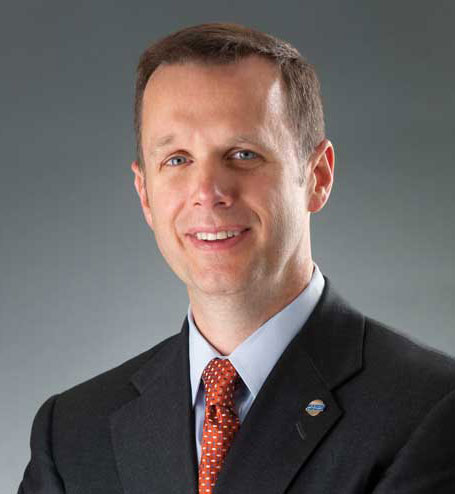As 2025 gets underway, HVAC professionals are looking ahead to what the new year and a new presidential administration will bring. The ACHR NEWS asked a few industry leaders for their predictions on what 2025 has in store for the industry.
Photos courtesy of the speaker.
Stephen Yurek
president, AHRI
– Stephen Yurek

2024 was definitely an interesting year for the industry — a lot of preparation for the refrigerant transition across all product lines effective January 1, 2025. That’s going very well, and I think it will continue in 2025. Hopefully, that will be an area where we see certainty and stability versus uncertainty, like we had in the last year, with building codes and other things.
I think the other big thing, along with the election and everything else, is the growth of uncertainty in this market as it relates to regulatory issues. In particular, we saw the Biden administration rushing to get regulations out, some of those impacting our industry: commercial refrigeration, automatic ice makers, as well as motors, and a couple of others. … The question becomes, will they be part of a request for rescission by Congress as part of the Congressional Review Act? — which we’ll see a lot of that over the first two to three months of this new Congress as they look not only at rules impacting us, but also all sorts of ones that were put out since the beginning of August by the Biden administration. What that does is provide uncertainty, and I think on the federal level, at least over the next year, we’re not going to see much rulemaking going on.
But by them not doing it, we’re going to see greater activities in the states, in particular, California, Washington, Massachusetts, New York, Illinois — basically the climate action states — both as relates to potential refrigerants and other things such as NOx emissions, which will cause significant issues for the industry and the availability of products to consumers.
Another thing that we’ve seen growing, but will probably be exacerbated because of state activities and everything else, is the whole question of affordability, and how our products will remain affordable to most of the consumers that are out there. As we increase efficiency, as we change refrigerants, everything has the tendency to increase the cost. So I think we’ll be needing to see how we can help consumers [afford the new equipment]. One of the solutions, of course, was the Inflation Reduction Act, and the rebates and the tax credits for 2025; those tax credits, I predict, will still be there.
AHRI will be launching, shortly after the first of the year, an update to its directory that will provide the 17-digit pin that the IRS and the IRA require for consumers to take that credit on their tax records. By putting in model numbers and some information, that certificate and PIN number will be produced, so contractors will be able to use that.
So I think that kind of summarizes it. 2025, I think, will be good for the industry. We’ll see the transition. We’ll see these programs, but there’s going to be a lot of uncertainty toward the end of the year on what’s going to happen, and what’s going to be available as we approach 2026.
Barton James
president and CEO, ACCA
– Barton James

From my background, I absolutely love what’s happening in Washington, D.C. in lots of ways. I know there aren’t many people who feel that way, but having spent more than half my life there, it’s hard for me not to be excited about what 2025 may hold for the future, especially for contractors and their employees. I felt like we were really making some progress in the Trump administration, and I felt like we had really taken some steps back from a regulatory standpoint — you know, what was coming at the manufacturer, and ultimately trickling down to the distributor, to the contractor, to the consumer, with just this onslaught of energy regulations and changes without a lot of thought being put into that. I think you’re already starting to see that surface in the new Congress.
But my predictions in terms of what’s happening? Opportunity. This is our chance for us to be united as an industry, but especially for the contractor, for the small business owner, to really make some advancements. We’ve got a lot of stuff on the tax front coming our way. That’s going to be center stage for us. The 199 deductions are one of those; minimum tax; and then just workforce in general. You’ve got the A2L transition — it’s going to happen, but you’re going to see some efforts to roll things back. And I think we need to be diligent on that.
In terms of predictions, I’m probably overly positive in terms of what’s happening. I’ve done two stints of duty as a political appointee in George W. Bush’s administration; I came back between campaigns twice to serve, and I’m excited about who’s already coming in. I think they’re going to do a better job of listening to experts — and this is where the expertise of small business owners, of contractors, matters — and hopefully turn back some of those horrible things that we saw: the OSHA walkaround rule, the Department of Labor joint employer rule, the corporate transparency from Department of Treasury, the ban on condensing furnaces. Hopefully getting apprenticeships back on track. Workforce continues to be our top constraint, for our members and, I believe, the whole industry, so any progress that we can make and having a meaningful apprentice program — not just for unions, for everybody — I think it’s going to be key.
So I think D.C. is going to be top of mind. I think it’s going to filter down the states. Some of the states that were already thinking they could go a little further left, from a political standpoint, got checked up pretty hard this past election — not just at the presidential level, but nationally. I think they’re going to be working to come back center, so it’s our chance to get back to what matters most, which are the people that pay the most in taxes, and that’s the contractor. We’re looking to leverage it fully.
Scott Merritt
owner, Fire & Ice Heating and Air Conditioning
– Scott Merritt

Three predictions that I have for 2025:
I believe that the end of the recession will be happening. I think there’s more optimism in the market. There’s already been more optimism in the market since the election, so I think there will be some changes from our new administration that will be more business-friendly, and I’ve already seen it at the kitchen table. There’s more people that are more optimistic. They’re more willing to spend money, as opposed to pre-election. So I think business … as long as you are working hard, getting your name out there and marketing, we’ll see an increase in sales revenue in 2025.
Second prediction: I think more thermostats will be AI-driven, so they’ll be taking everything into account — how your systems running, how long it’s on — and will be learning to optimize more in learning their schedule. And I know some aspects of that are already going on, but I think that the controls that are in place to run our HVAC systems are going to become more AI-driven over the next two years for the betterment of efficiency and, of course, control from the manufacturers so they can get more information. There’s always a tradeoff with privacy, but overall, I think it’ll make more comfort happen.
My third prediction for 2025 is crypto stablecoins. I think they’ve become more mainstream, and I think more people are going to be using them for payment. I think people will be using Visa, MasterCard less by the end of the year, because those fees are high compared to what you can get with stablecoin. I think that’ll be one of the biggest things that we see with the new administration government coming in — some stablecoin regulation, which will make it easier for companies to be able to transfer money everywhere with lower fees. Ultimately, that’s what stablecoins are for.
Talbot Gee
CEO, HARDI
– Talbot Gee

When I look at the whole market for 2025, our expectation is that actually our fundamentals and the market potential are going to be better in ‘25 than it was in ’24, for a variety of reasons. That’s No. 1.
No. 2 is we are going through yet another form of some kind of technology or product transition; this time happened to be the refrigerant transition, and while everyone has worked exceedingly hard to be prepared for all of this, there’s going to be the unknown, there’s going to be the unexpected, there’s going to be the unplanned disruption that’s going to create some challenges. It might be for the manufacturer, it might be for one of their component manufacturers. It might be in transportation, it might be in the distribution or the sales channel. There’s going to be a disruption that’s going to create some disconnect between market demand and product supply, at some point, for some category of product. And so that is our expectation, and it’s going to be up to how well the industry deals with that.
And then I think the third thing is tangential to that: continued increased activity on the state and local level as it relates to policy that impacts our members. Not all of it is necessarily bad, but there’s an awful lot of it that’s not great, and it can be anywhere from state agency regulation to code adoption or code interpretation and implementation, and it could be legislative affairs at the state level. We expect to see more and more of that. We are already dealing with it in a number of states. We think in 2025, it’s likely to ramp up. And by the way, it’s not really a political statement. We saw this as happening regardless of who was going to win the presidential election … it was going to happen one way or another, and a big part of that is there’s no federal preemption on climate-related policy, which dictates an awful lot of the refrigerants and other materials in our industry.
So those are probably three big impacts. If I were going to say what I think the key will be to all of this, it’s going to be on execution. … It’s going to be everyone involved who [needs to] really know their stuff and can really speak with authority and confidence and know where all the right information is to have it at their fingertips to help serve their customers. Because there’s going to be a lot of misinformation out there. There’s going to be a lot of incorrect interpretations of what the refrigerant transition means, or what code compliance means, or what you’re allowed or not allowed to do with a certain product in a certain area of the country. And so those who really know it — and know it well and win the confidence of their customers — are going to have an opportunity for a disproportional growth opportunity in 2025, while on the flip side, those who don’t run the risk of being exposed and having a very, very challenging 2025. So staying educated, staying creative, staying strategic, focusing on your customer, and answering and anticipating their needs is going to be even more important in 2025.

